Capital Investment Appraisal Report: Machine Selection in Business
VerifiedAdded on 2023/06/14
|6
|1335
|499
Report
AI Summary
This report evaluates capital investment appraisal measures, including Net Present Value (NPV), Internal Rate of Return (IRR), Accounting Rate of Return (ARR), and payback period, to recommend the best machine selection (A20 or B25) for a business. It analyzes the financial viability of each machine based on these techniques, highlighting the strengths and weaknesses of each method. The report also addresses the director of Finance's claim regarding IRR exceeding 7%, providing reasons and explanations based on NPV and project benefits. Ultimately, it concludes on the importance of investment appraisal techniques in project evaluation and decision-making.
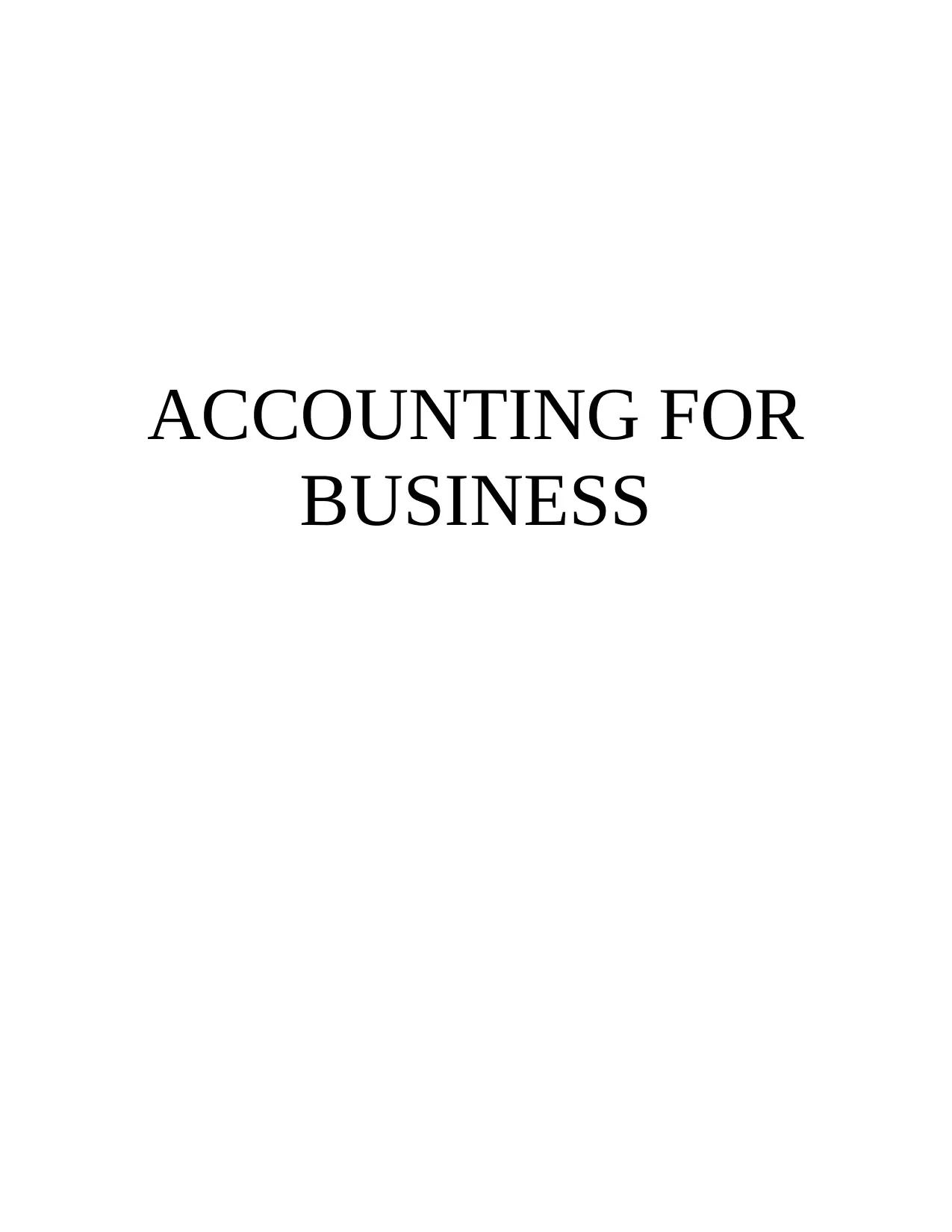
ACCOUNTING FOR
BUSINESS
BUSINESS
Paraphrase This Document
Need a fresh take? Get an instant paraphrase of this document with our AI Paraphraser
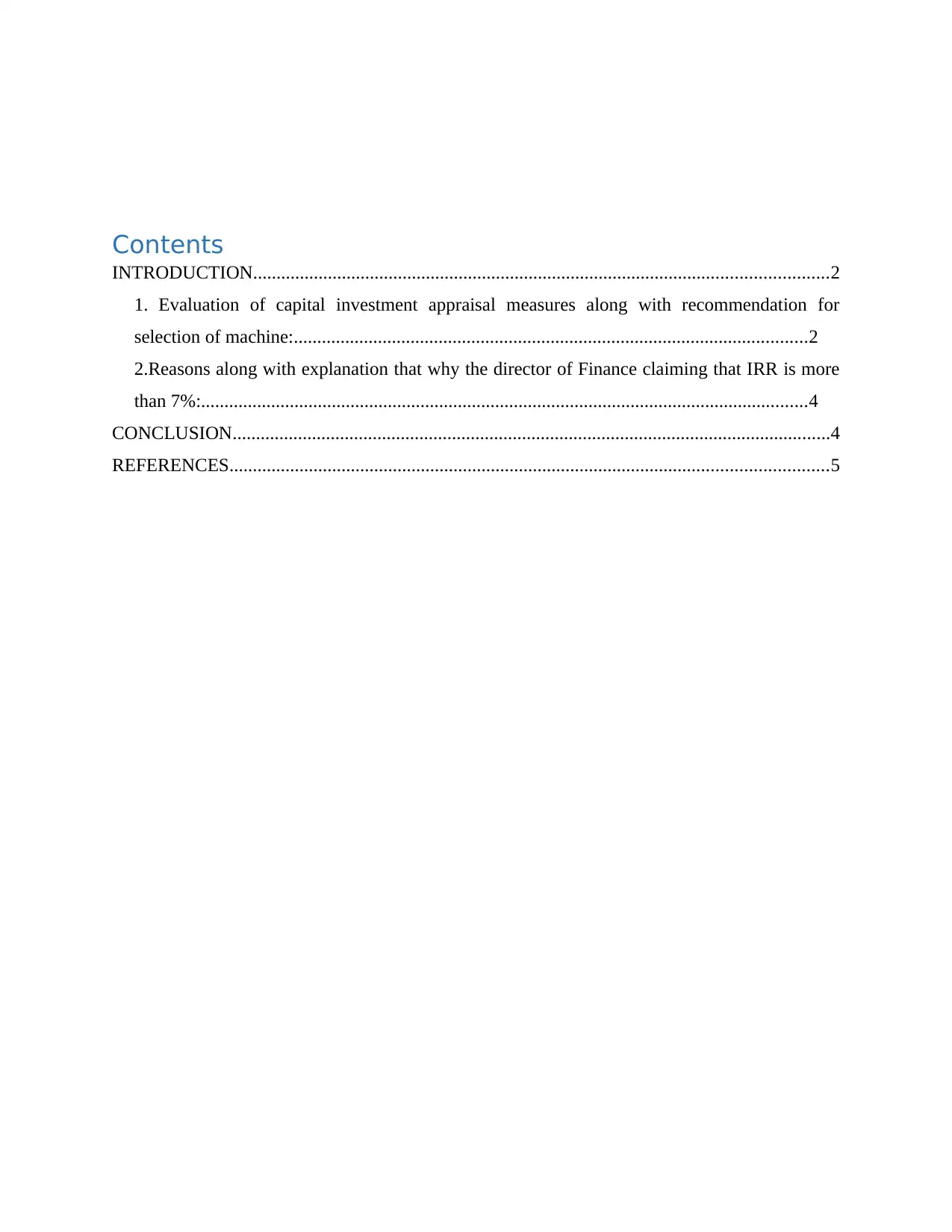
Contents
INTRODUCTION...........................................................................................................................2
1. Evaluation of capital investment appraisal measures along with recommendation for
selection of machine:..............................................................................................................2
2.Reasons along with explanation that why the director of Finance claiming that IRR is more
than 7%:..................................................................................................................................4
CONCLUSION................................................................................................................................4
REFERENCES................................................................................................................................5
INTRODUCTION...........................................................................................................................2
1. Evaluation of capital investment appraisal measures along with recommendation for
selection of machine:..............................................................................................................2
2.Reasons along with explanation that why the director of Finance claiming that IRR is more
than 7%:..................................................................................................................................4
CONCLUSION................................................................................................................................4
REFERENCES................................................................................................................................5
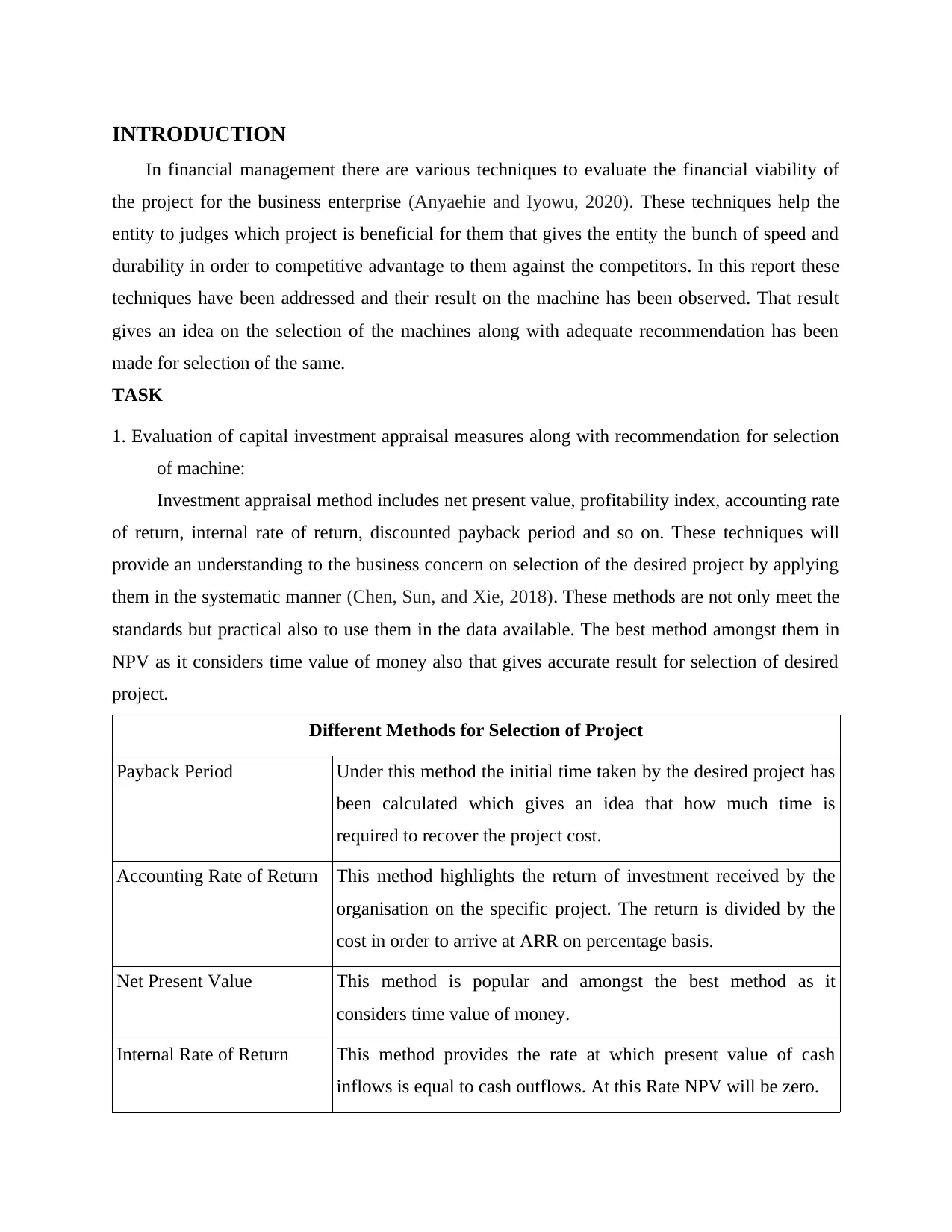
INTRODUCTION
In financial management there are various techniques to evaluate the financial viability of
the project for the business enterprise (Anyaehie and Iyowu, 2020). These techniques help the
entity to judges which project is beneficial for them that gives the entity the bunch of speed and
durability in order to competitive advantage to them against the competitors. In this report these
techniques have been addressed and their result on the machine has been observed. That result
gives an idea on the selection of the machines along with adequate recommendation has been
made for selection of the same.
TASK
1. Evaluation of capital investment appraisal measures along with recommendation for selection
of machine:
Investment appraisal method includes net present value, profitability index, accounting rate
of return, internal rate of return, discounted payback period and so on. These techniques will
provide an understanding to the business concern on selection of the desired project by applying
them in the systematic manner (Chen, Sun, and Xie, 2018). These methods are not only meet the
standards but practical also to use them in the data available. The best method amongst them in
NPV as it considers time value of money also that gives accurate result for selection of desired
project.
Different Methods for Selection of Project
Payback Period Under this method the initial time taken by the desired project has
been calculated which gives an idea that how much time is
required to recover the project cost.
Accounting Rate of Return This method highlights the return of investment received by the
organisation on the specific project. The return is divided by the
cost in order to arrive at ARR on percentage basis.
Net Present Value This method is popular and amongst the best method as it
considers time value of money.
Internal Rate of Return This method provides the rate at which present value of cash
inflows is equal to cash outflows. At this Rate NPV will be zero.
In financial management there are various techniques to evaluate the financial viability of
the project for the business enterprise (Anyaehie and Iyowu, 2020). These techniques help the
entity to judges which project is beneficial for them that gives the entity the bunch of speed and
durability in order to competitive advantage to them against the competitors. In this report these
techniques have been addressed and their result on the machine has been observed. That result
gives an idea on the selection of the machines along with adequate recommendation has been
made for selection of the same.
TASK
1. Evaluation of capital investment appraisal measures along with recommendation for selection
of machine:
Investment appraisal method includes net present value, profitability index, accounting rate
of return, internal rate of return, discounted payback period and so on. These techniques will
provide an understanding to the business concern on selection of the desired project by applying
them in the systematic manner (Chen, Sun, and Xie, 2018). These methods are not only meet the
standards but practical also to use them in the data available. The best method amongst them in
NPV as it considers time value of money also that gives accurate result for selection of desired
project.
Different Methods for Selection of Project
Payback Period Under this method the initial time taken by the desired project has
been calculated which gives an idea that how much time is
required to recover the project cost.
Accounting Rate of Return This method highlights the return of investment received by the
organisation on the specific project. The return is divided by the
cost in order to arrive at ARR on percentage basis.
Net Present Value This method is popular and amongst the best method as it
considers time value of money.
Internal Rate of Return This method provides the rate at which present value of cash
inflows is equal to cash outflows. At this Rate NPV will be zero.
⊘ This is a preview!⊘
Do you want full access?
Subscribe today to unlock all pages.

Trusted by 1+ million students worldwide
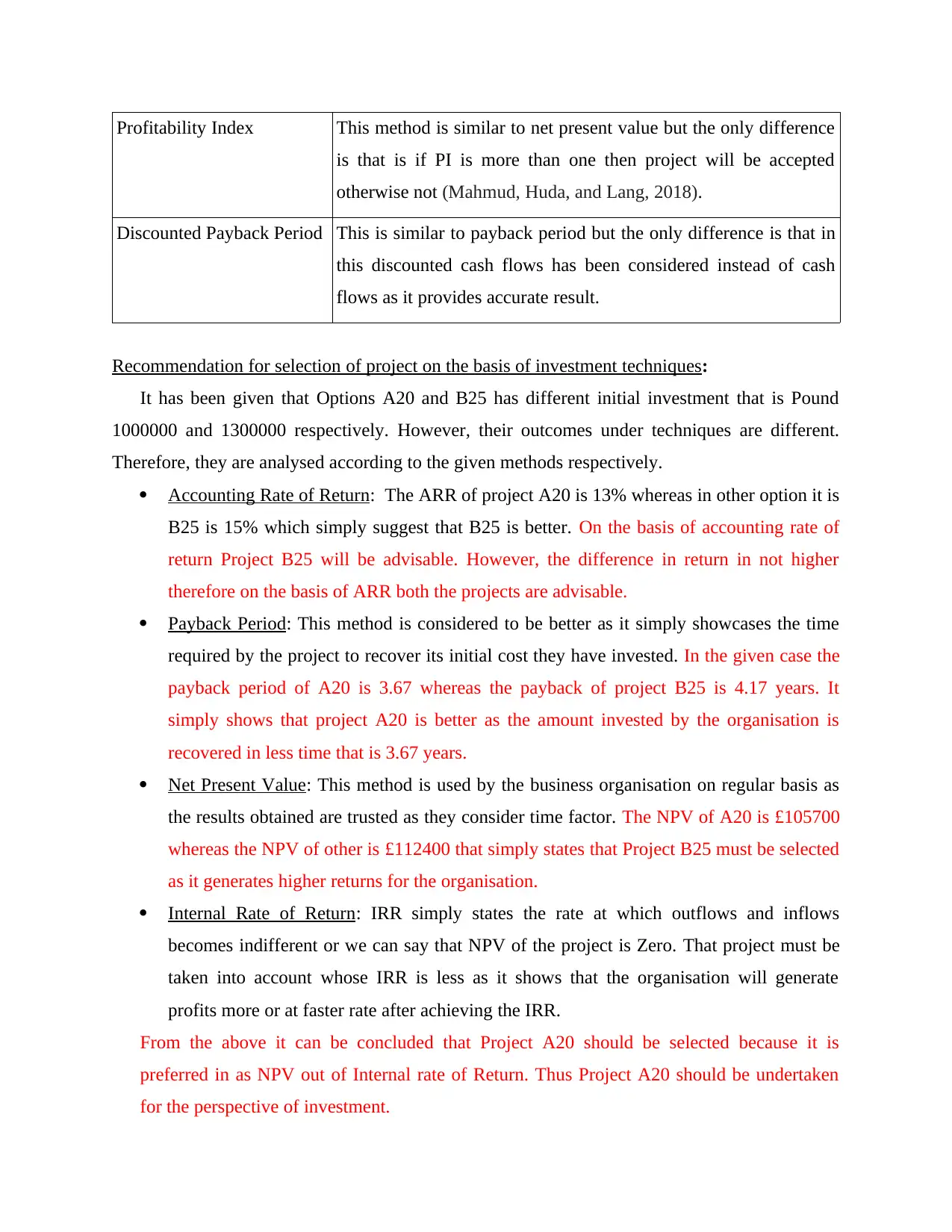
Profitability Index This method is similar to net present value but the only difference
is that is if PI is more than one then project will be accepted
otherwise not (Mahmud, Huda, and Lang, 2018).
Discounted Payback Period This is similar to payback period but the only difference is that in
this discounted cash flows has been considered instead of cash
flows as it provides accurate result.
Recommendation for selection of project on the basis of investment techniques:
It has been given that Options A20 and B25 has different initial investment that is Pound
1000000 and 1300000 respectively. However, their outcomes under techniques are different.
Therefore, they are analysed according to the given methods respectively.
Accounting Rate of Return: The ARR of project A20 is 13% whereas in other option it is
B25 is 15% which simply suggest that B25 is better. On the basis of accounting rate of
return Project B25 will be advisable. However, the difference in return in not higher
therefore on the basis of ARR both the projects are advisable.
Payback Period: This method is considered to be better as it simply showcases the time
required by the project to recover its initial cost they have invested. In the given case the
payback period of A20 is 3.67 whereas the payback of project B25 is 4.17 years. It
simply shows that project A20 is better as the amount invested by the organisation is
recovered in less time that is 3.67 years.
Net Present Value: This method is used by the business organisation on regular basis as
the results obtained are trusted as they consider time factor. The NPV of A20 is £105700
whereas the NPV of other is £112400 that simply states that Project B25 must be selected
as it generates higher returns for the organisation.
Internal Rate of Return: IRR simply states the rate at which outflows and inflows
becomes indifferent or we can say that NPV of the project is Zero. That project must be
taken into account whose IRR is less as it shows that the organisation will generate
profits more or at faster rate after achieving the IRR.
From the above it can be concluded that Project A20 should be selected because it is
preferred in as NPV out of Internal rate of Return. Thus Project A20 should be undertaken
for the perspective of investment.
is that is if PI is more than one then project will be accepted
otherwise not (Mahmud, Huda, and Lang, 2018).
Discounted Payback Period This is similar to payback period but the only difference is that in
this discounted cash flows has been considered instead of cash
flows as it provides accurate result.
Recommendation for selection of project on the basis of investment techniques:
It has been given that Options A20 and B25 has different initial investment that is Pound
1000000 and 1300000 respectively. However, their outcomes under techniques are different.
Therefore, they are analysed according to the given methods respectively.
Accounting Rate of Return: The ARR of project A20 is 13% whereas in other option it is
B25 is 15% which simply suggest that B25 is better. On the basis of accounting rate of
return Project B25 will be advisable. However, the difference in return in not higher
therefore on the basis of ARR both the projects are advisable.
Payback Period: This method is considered to be better as it simply showcases the time
required by the project to recover its initial cost they have invested. In the given case the
payback period of A20 is 3.67 whereas the payback of project B25 is 4.17 years. It
simply shows that project A20 is better as the amount invested by the organisation is
recovered in less time that is 3.67 years.
Net Present Value: This method is used by the business organisation on regular basis as
the results obtained are trusted as they consider time factor. The NPV of A20 is £105700
whereas the NPV of other is £112400 that simply states that Project B25 must be selected
as it generates higher returns for the organisation.
Internal Rate of Return: IRR simply states the rate at which outflows and inflows
becomes indifferent or we can say that NPV of the project is Zero. That project must be
taken into account whose IRR is less as it shows that the organisation will generate
profits more or at faster rate after achieving the IRR.
From the above it can be concluded that Project A20 should be selected because it is
preferred in as NPV out of Internal rate of Return. Thus Project A20 should be undertaken
for the perspective of investment.
Paraphrase This Document
Need a fresh take? Get an instant paraphrase of this document with our AI Paraphraser
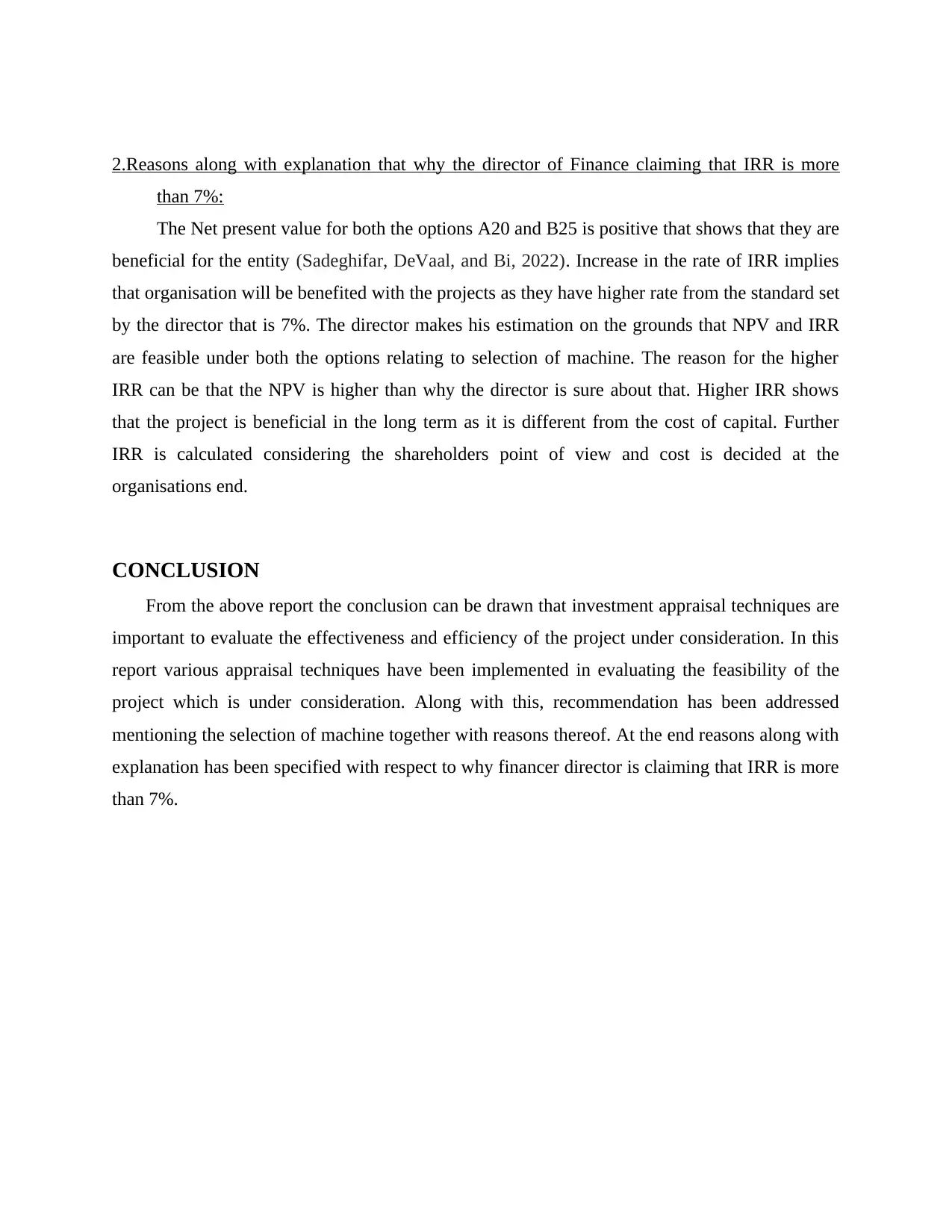
2.Reasons along with explanation that why the director of Finance claiming that IRR is more
than 7%:
The Net present value for both the options A20 and B25 is positive that shows that they are
beneficial for the entity (Sadeghifar, DeVaal, and Bi, 2022). Increase in the rate of IRR implies
that organisation will be benefited with the projects as they have higher rate from the standard set
by the director that is 7%. The director makes his estimation on the grounds that NPV and IRR
are feasible under both the options relating to selection of machine. The reason for the higher
IRR can be that the NPV is higher than why the director is sure about that. Higher IRR shows
that the project is beneficial in the long term as it is different from the cost of capital. Further
IRR is calculated considering the shareholders point of view and cost is decided at the
organisations end.
CONCLUSION
From the above report the conclusion can be drawn that investment appraisal techniques are
important to evaluate the effectiveness and efficiency of the project under consideration. In this
report various appraisal techniques have been implemented in evaluating the feasibility of the
project which is under consideration. Along with this, recommendation has been addressed
mentioning the selection of machine together with reasons thereof. At the end reasons along with
explanation has been specified with respect to why financer director is claiming that IRR is more
than 7%.
than 7%:
The Net present value for both the options A20 and B25 is positive that shows that they are
beneficial for the entity (Sadeghifar, DeVaal, and Bi, 2022). Increase in the rate of IRR implies
that organisation will be benefited with the projects as they have higher rate from the standard set
by the director that is 7%. The director makes his estimation on the grounds that NPV and IRR
are feasible under both the options relating to selection of machine. The reason for the higher
IRR can be that the NPV is higher than why the director is sure about that. Higher IRR shows
that the project is beneficial in the long term as it is different from the cost of capital. Further
IRR is calculated considering the shareholders point of view and cost is decided at the
organisations end.
CONCLUSION
From the above report the conclusion can be drawn that investment appraisal techniques are
important to evaluate the effectiveness and efficiency of the project under consideration. In this
report various appraisal techniques have been implemented in evaluating the feasibility of the
project which is under consideration. Along with this, recommendation has been addressed
mentioning the selection of machine together with reasons thereof. At the end reasons along with
explanation has been specified with respect to why financer director is claiming that IRR is more
than 7%.
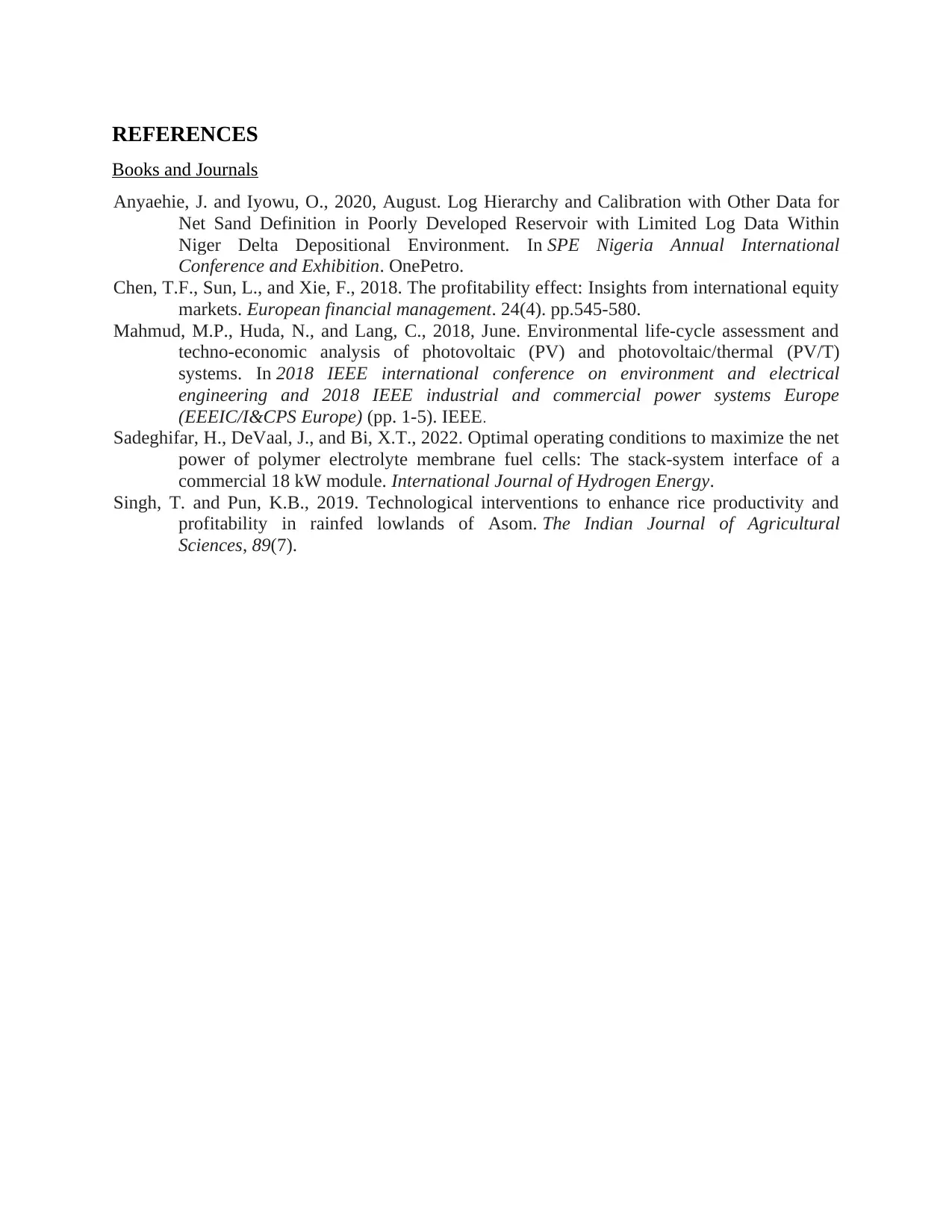
REFERENCES
Books and Journals
Anyaehie, J. and Iyowu, O., 2020, August. Log Hierarchy and Calibration with Other Data for
Net Sand Definition in Poorly Developed Reservoir with Limited Log Data Within
Niger Delta Depositional Environment. In SPE Nigeria Annual International
Conference and Exhibition. OnePetro.
Chen, T.F., Sun, L., and Xie, F., 2018. The profitability effect: Insights from international equity
markets. European financial management. 24(4). pp.545-580.
Mahmud, M.P., Huda, N., and Lang, C., 2018, June. Environmental life-cycle assessment and
techno-economic analysis of photovoltaic (PV) and photovoltaic/thermal (PV/T)
systems. In 2018 IEEE international conference on environment and electrical
engineering and 2018 IEEE industrial and commercial power systems Europe
(EEEIC/I&CPS Europe) (pp. 1-5). IEEE.
Sadeghifar, H., DeVaal, J., and Bi, X.T., 2022. Optimal operating conditions to maximize the net
power of polymer electrolyte membrane fuel cells: The stack-system interface of a
commercial 18 kW module. International Journal of Hydrogen Energy.
Singh, T. and Pun, K.B., 2019. Technological interventions to enhance rice productivity and
profitability in rainfed lowlands of Asom. The Indian Journal of Agricultural
Sciences, 89(7).
Books and Journals
Anyaehie, J. and Iyowu, O., 2020, August. Log Hierarchy and Calibration with Other Data for
Net Sand Definition in Poorly Developed Reservoir with Limited Log Data Within
Niger Delta Depositional Environment. In SPE Nigeria Annual International
Conference and Exhibition. OnePetro.
Chen, T.F., Sun, L., and Xie, F., 2018. The profitability effect: Insights from international equity
markets. European financial management. 24(4). pp.545-580.
Mahmud, M.P., Huda, N., and Lang, C., 2018, June. Environmental life-cycle assessment and
techno-economic analysis of photovoltaic (PV) and photovoltaic/thermal (PV/T)
systems. In 2018 IEEE international conference on environment and electrical
engineering and 2018 IEEE industrial and commercial power systems Europe
(EEEIC/I&CPS Europe) (pp. 1-5). IEEE.
Sadeghifar, H., DeVaal, J., and Bi, X.T., 2022. Optimal operating conditions to maximize the net
power of polymer electrolyte membrane fuel cells: The stack-system interface of a
commercial 18 kW module. International Journal of Hydrogen Energy.
Singh, T. and Pun, K.B., 2019. Technological interventions to enhance rice productivity and
profitability in rainfed lowlands of Asom. The Indian Journal of Agricultural
Sciences, 89(7).
⊘ This is a preview!⊘
Do you want full access?
Subscribe today to unlock all pages.

Trusted by 1+ million students worldwide
1 out of 6
Related Documents
Your All-in-One AI-Powered Toolkit for Academic Success.
+13062052269
info@desklib.com
Available 24*7 on WhatsApp / Email
![[object Object]](/_next/static/media/star-bottom.7253800d.svg)
Unlock your academic potential
Copyright © 2020–2025 A2Z Services. All Rights Reserved. Developed and managed by ZUCOL.





